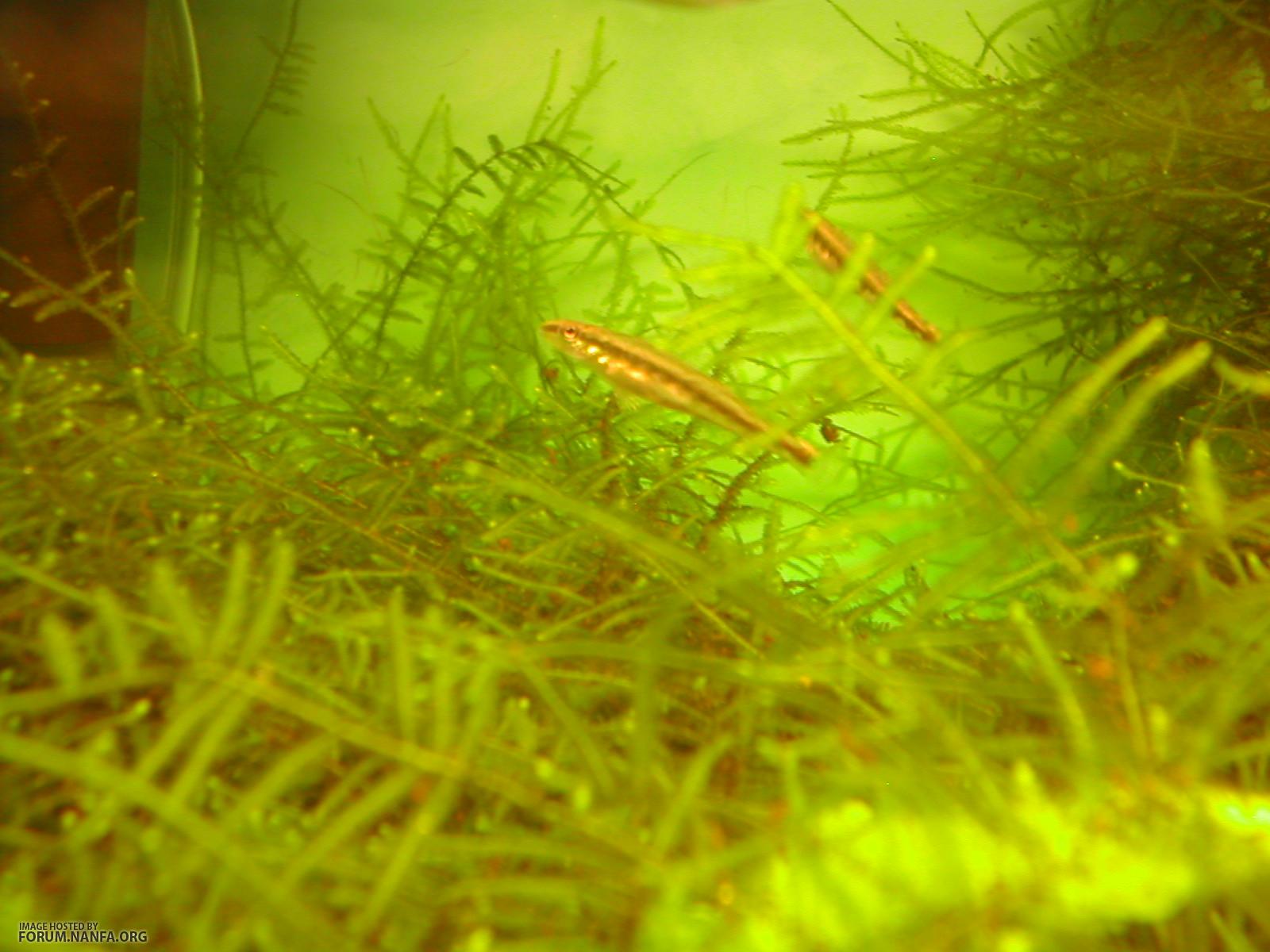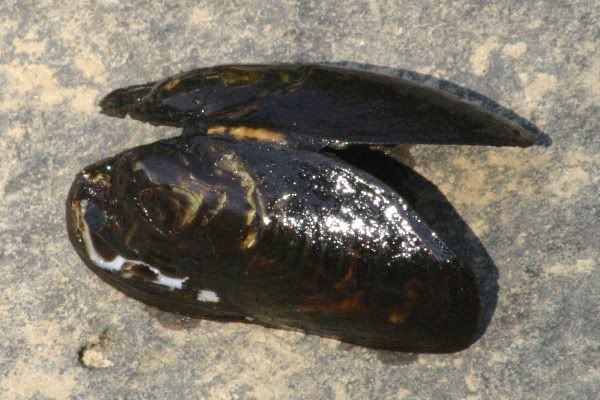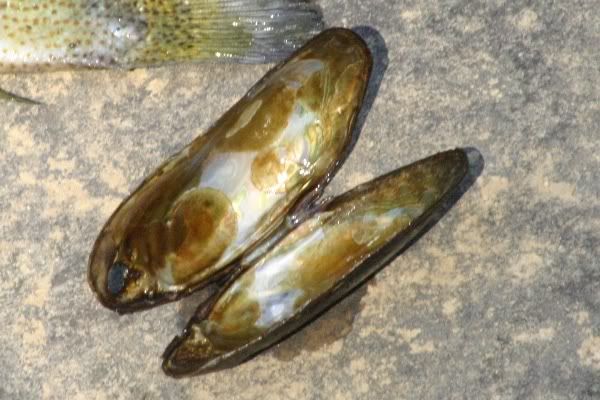Last Friday Rob and i headed south to the Little River. The park is called The Little River Canyon MOUTH park and yes it is 3 bucks per carload, tho no one was at the entrance to take the cash. Not many people were enjoying the park on such a pretty day but the weekends can be crazy crowded with the Latino sock workers from the surrounding textile mills. The weather had cooled a wee bit from the summer's burning heat of the weeks prior and actually the water felt warmer than the air several times when we walked along the shallows.
Water flow was to a bare minimum, maybe reduced to about 1' deep and 2 or 3' wide in some of the channeled riffle runs. Rain had fallen on Lookout Mountain the day before but no evidence of it was seen in volume or turbidity. Visibility was murky in someplaces and only 6 feet at best but oddly in some of the pools we could see 15 feet straight down.
Immediatly upon entering at a back water pool i observed schools of shiners though they were not in any kind of breeding color. I suspect the first ones were Blue Shiners from their vegetated, sandy backwater habitat and their lateral stripe running into an elongated caudal spot. A couple other species were with them but i really have no idea what they were. Perhaps Burrhead or Coosas. Unless i see high males i'm often at a loss.
All and all we counted 21 species we knew and 4 or 5 we were unsure of, and several more complete unknowns.
Sunfish: Redbreast, Bluegill, Green, Croppie, Coosa Bass and Largemouth bass. Maybe Smallmouth or Spotted.
Channel Cats, Longnose Gar, Drum.
Hogsuckers, Stonerollers, 2 species of Redhorse at least, Blacktail and Spotted. Lots of Redhorses and Suckers.
Southern Studfish in the warm shallows close to the banks. Didnt crook my neck looking for Gambusia.
Shiners: Alabama, Tricolor, Blue and several unknowns. Stripes.
Darters: Bronze, Mobile Logperch, Speckled, Greenbreast and lots of juvi mystery Darters... either Blackbanded or perhaps Muscadine? Help me learn.
What i also expected to see were Longear and Shadow Bass. Surely iv'e seen them here before.
Several places offered memorable viewings. One was in a deep bouldered pool. The light was streaming down from overhead and descending into the depths as shadowed shimmering pulsing rays. Below circled and ran Drum and Redhorse. A group of Croppie were stairstep staggered down along a vertical submerged and broken limbed tree. We dove down and held to the branches to get an eye on the shimmery Croppie, White or Black i know not, but they were beautiful with their elongated dorsal and ventral angel fins. As we took turns diving down a 4' Longnose Gar cruised by and Rob swam alongside for several passes before the Gar headed to another pool evading Rob's ever nearing gaze. While i snorkeled through the boulder crevases Rob removed his wetsuit and climbed to the highest boulder and lept off with a yippee yell and plunged deep into the clear pool. It was a fine day.
Rob pointed out that i had been overlooking the Green Sunnies. Sure enough i quickly learned they were hiding in the shadowed cracks and crevases along the river's edges. A little wiggle of a stick's end would lure them out and how fine they were marked. Handsome but content to hide their beauty in the shadows unless you happened to be a mindless minnow drifting by. And minnows galore, clouds of them at several locations. Schools moving as one with Bass and Sunfish darting in as opportunity presented itself. There was not a shortage this year in minnow mass and the big fish were noting it.
Rob also pointed out small Darters, just and inch or a bit longer snaking along the surface of rocks. A very odd manner of movement. Almost slinky. Hundreds of them scattered along the rocky edges of the quiet flows. Sometimes they would act like Percina, reminding me of the Blackbandeds or the Bridal Darters i see in the Conasauga. But these were small and no adults of either specie were seen, though consistently looked for. I have noted this late in the year, at several sites i have snorkeled, that the quanity of fish seems to be diminished. I'm not sure of this but it seems consistant. However there were plenty of these Darters and many schools of young Shiners. The riffle runs is what seemed to lack the specie diversity and quanity i'm use to observing here.
During a open book picnic lunch we talked to a few folks who inquired of our snorkeling activity. One group was from Atlanta and committed to returning with their snorkel gear. They pointed out several large Gar nosing their long snouts out of the water porpoise style. I'm seeing more folks with masks now and finding more lost gear in downstream pools. It is fun and people seem genuinely interested when your showing them pictures or while describing recent views. This would be a good time to give them a card with NANFA's website on it. I suspect most folks cant recall the letters N A N F A dot org.
Yellow jackets were buzzing us pretty good and i had been regularily wiping my chin of sardine drippings when i picked the waded oily paper towel back up. My thumb still tingles from that yeow sting. At least it was not my lip thankfully. Rob got into something along the wooded bank and grew a big red rash behind his ear. We took a pic of our damages, swollen thumb next to a reddened ear, but he is on his way back to St. Louis and a Master's degree and the digital image is on his camera chip, that is, if you wanted to see our day's pain in color.
The sun was getting low and i hurridly caught a Logperch, 3 of the little mystery Darters and ran my net though a school of Shiners in hopes of growing them out and iding them in the studio glass. I figure we spent about 5 hours in the river heading upstream and then drifting back to pools below the park. Probably 6 or 7 hours alltogether at the site.
Getting rinsed off and loaded up we headed back across the ridge, overlooked DeSota Falls from the high bridge and ran across the flat of the mountain. A quick u-turn bought us a 50 lb bag of Sand Mountain red potatoes for 12 bucks and all the figs we could pick and eat. They were good! After settling up, down into the Ft. Payne valley and found a Mexican restaurant on the north end of town that used no english. My feeble attempts at 2nd grade spanish bought me a piece of fluffy flat crusty bread covered with fresh avacado, roasted chicken, bologna, braised beef pieces, a slathering of fruit jam, ( how odd is that? ), 2 cheeses, lettuce, cilantro, herbs and sliced tomato smoothed over with some kind of creamy sauce. A cold bottle of espanol branded orange soda and a creme pastry from the wall sized, under glass display case. The young lady brought us 3 kinds of salsa, a plate of pickled peppers and vegetables and a basket of dark brown thick crunchy chips. Pretty tasty after a full day drifting in a cool river. Studying the menu i was finally able to cipher some of the ingredients and i think the beef pieces were beef tongue!
We got back to Rob's parents, divided the potatoes and watched a bit of the spectacular opening of the 08 olympics.
Sunday afternoon Rob visited the house, we snorkeled the cement pond, seined South Chickamauga Creek and cooked up the last of the Conasauga Drum.
Fine weekend. Rob had helped me with the 98 NANFA gathering here in Chattanooga. He is quite a bit younger than me but we have enjoyed each other's company snorkeling, camping and hunting mushrooms. One summer he helped me remodel our home on Blue Fish Ridge. He is getting his masters in Bio-Ethics in St. Louis. A fine person to spend time with.
I've tried 3 times with different settings to get a pic of this darter. Help Mr. Uland.

Maybe this will work as an id aid. If not i will try again later.







